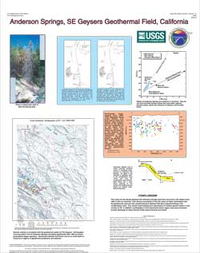Abrupt physical and chemical changes during 1992-1999, Anderson Springs, SE Geyser Geothermal Field, California
Links
- More information: USGS Index Page (html)
- Document: Report
- Download citation as: RIS | Dublin Core
Abstract
The Anderson Springs area is located about 90 miles (145 kilometers) north of San Francisco, California, in the southwestern part of Lake County. The area was first developed in the late 1800s as a health resort, which was active until the 1930s. Patrons drank a variety of cool to hot mineral waters from improved springs, swam in various baths and pools, and hiked in the rugged hills flanking Anderson Creek and its tributaries. In the bluffs to the south of the resort were four small mercury mines of the eastern Mayacmas quicksilver district. About 1,260 flasks of mercury were produced from these mines between 1909 and 1943. By the early 1970s, the higher ridges south and west of Anderson Springs became part of the southeast sector of the greater Geysers geothermal field. Today, several electric power plants are built on these ridges, producing energy from a vapor-dominated 240 °C reservoir. Only the main hot spring at Anderson Springs has maintained a recognizable identity since the 1930s. The hot spring is actually a cluster of seeps and springs that issue from a small fault in a ravine southwest of Anderson Creek. Published and unpublished records show that the maximum temperature (Tm) of this cluster fell gradually from 63°C in 1889 to 48°C in 1992. However, Tm of the cluster climbed to 77°C in 1995 and neared boiling (98°C) in 1998. A new cluster of boiling vents and small fumaroles (Tm = 99.3°C) formed in 1998 about 30 m north of the old spring cluster. Several evergreen trees on steep slopes immediately above these vents apparently were killed by the new activity.
Thermal waters at Anderson Hot Springs are mostly composed of near-surface ground waters with some added gases and condensed steam from The Geysers geothermal system. Compared to gas samples from Southeast Geysers wells, the hot spring gases are higher in CO2 and lower in H2S and NH3. As the springs increased in temperature, however, the gas composition became more like the mean composition of steam discharges from the Southeast Geysers. The hot spring waters are low in ions of Cl, B, and Li, but relatively high in HCO3, SO4 and NH4. The stable-isotope compositions (deuterium and oxygen-18) of these waters plot near the global meteoric water line. Geochemical data through time reveal apparent maxima in the concentrations of SO4, Fe, and Mn in 1991 to 1992, before the cluster became hotter. The black-to-gray deposits from the new spring cluster are rich in pyrite and contain anomalous metals. About one-half mile to the east of the hot springs, mineralized water discharges intermittently from an old adit of the Schwartz (Anderson) mine, and enters a tributary of Anderson Creek. This drainage increased substantially in July 1998, and a slurry of mine water and precipitates were transported down the tributary and into Anderson Creek. In December 1998, the adit water was 22°C, and had a chemical composition that was similar to spring waters that once discharged in the ravines surrounding the old Anderson Springs resort.
The cause for the abrupt changes that have occurred in thermal features at Anderson Springs is still not resolved. One possibility is that these changes are a response to withdrawal of steam from The Geysers geothermal field over more than 20 years of production. Pressure declines in the geothermal reservoir may have caused a "drying out" of the overlying condensation zone. Induced boiling in this zone and upflow of deep steam to shallower depths would cause heating and vaporization of shallow ground waters. In addition, earthquakes occurring in the vicinity of Anderson Springs have increased significantly after nearby geothermal power plants began operation. These earthquakes may have enhanced surface discharge of thermal fluids along fractures and faults.
Study Area
| Publication type | Report |
|---|---|
| Publication Subtype | USGS Numbered Series |
| Title | Abrupt physical and chemical changes during 1992-1999, Anderson Springs, SE Geyser Geothermal Field, California |
| Series title | Open-File Report |
| Series number | 2000-37 |
| DOI | 10.3133/ofr0037 |
| Year Published | 2000 |
| Language | English |
| Publisher | U.S. Geological Survey |
| Description | Poster: 2 sheets |
| Country | United States |
| State | California |
| County | Lake County |
| Other Geospatial | Anderson Springs |


